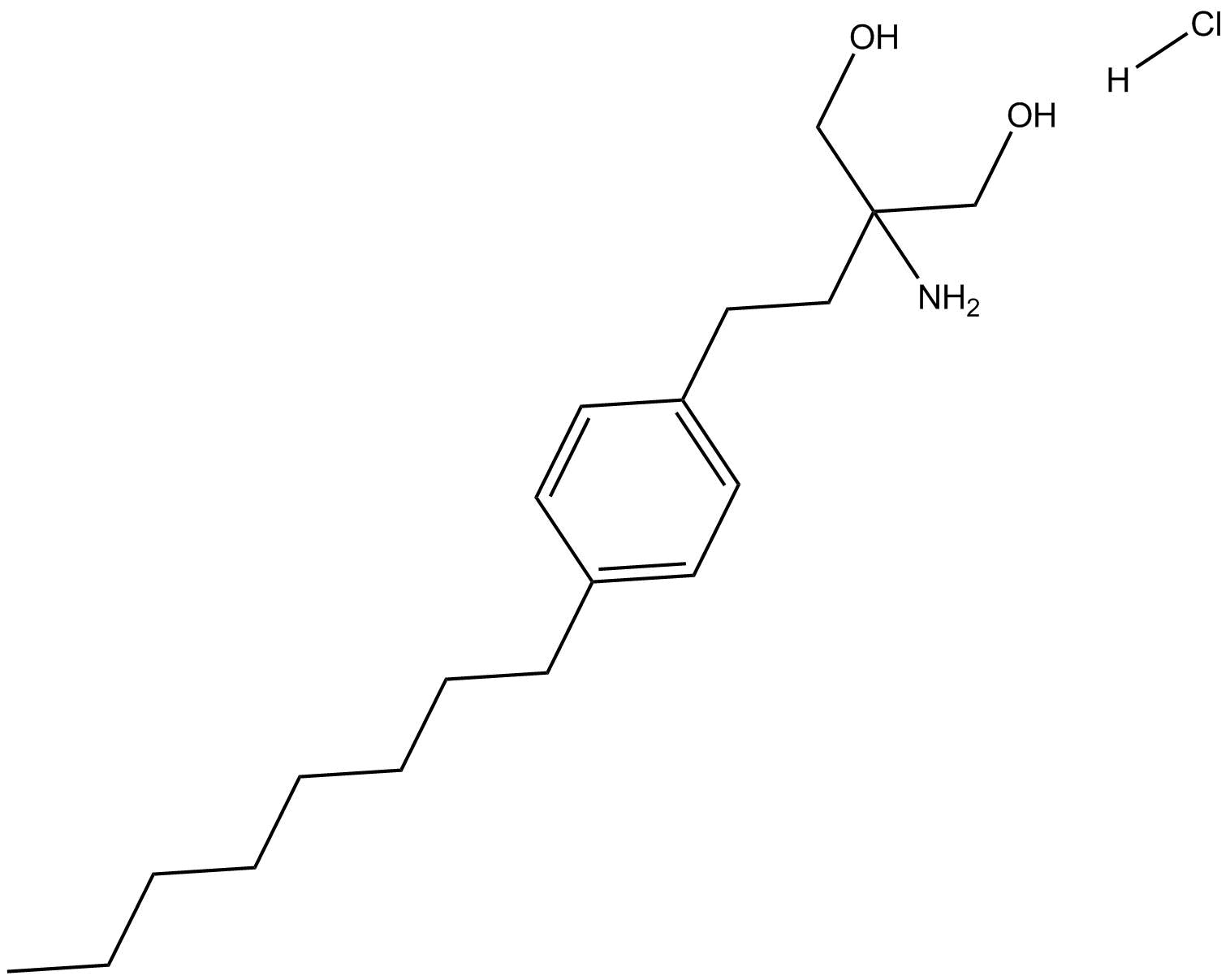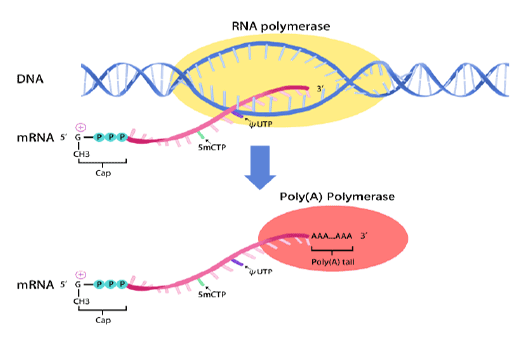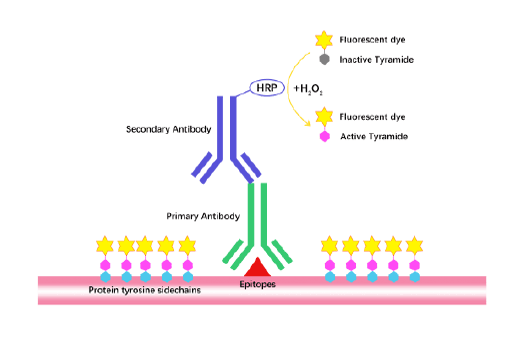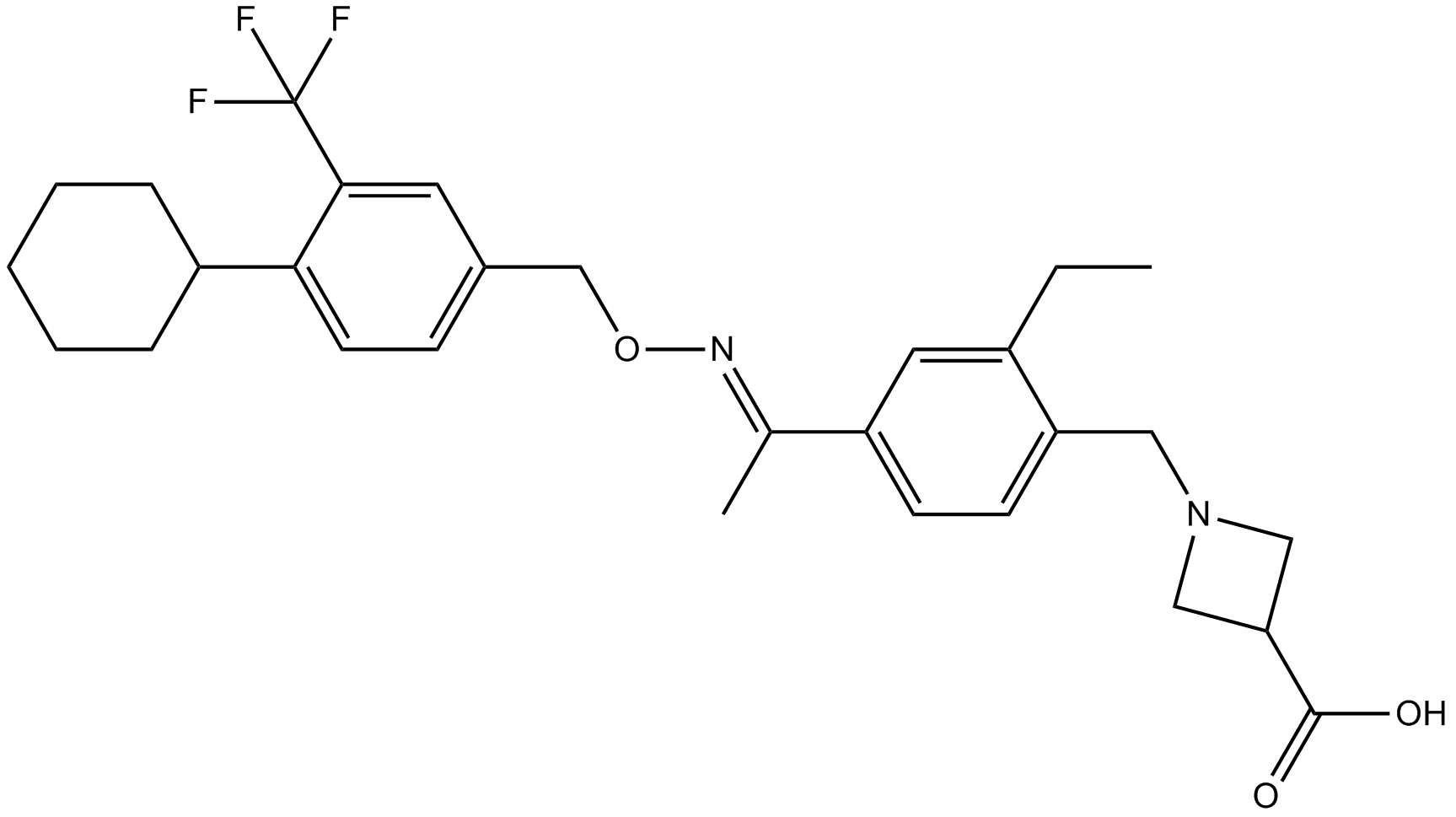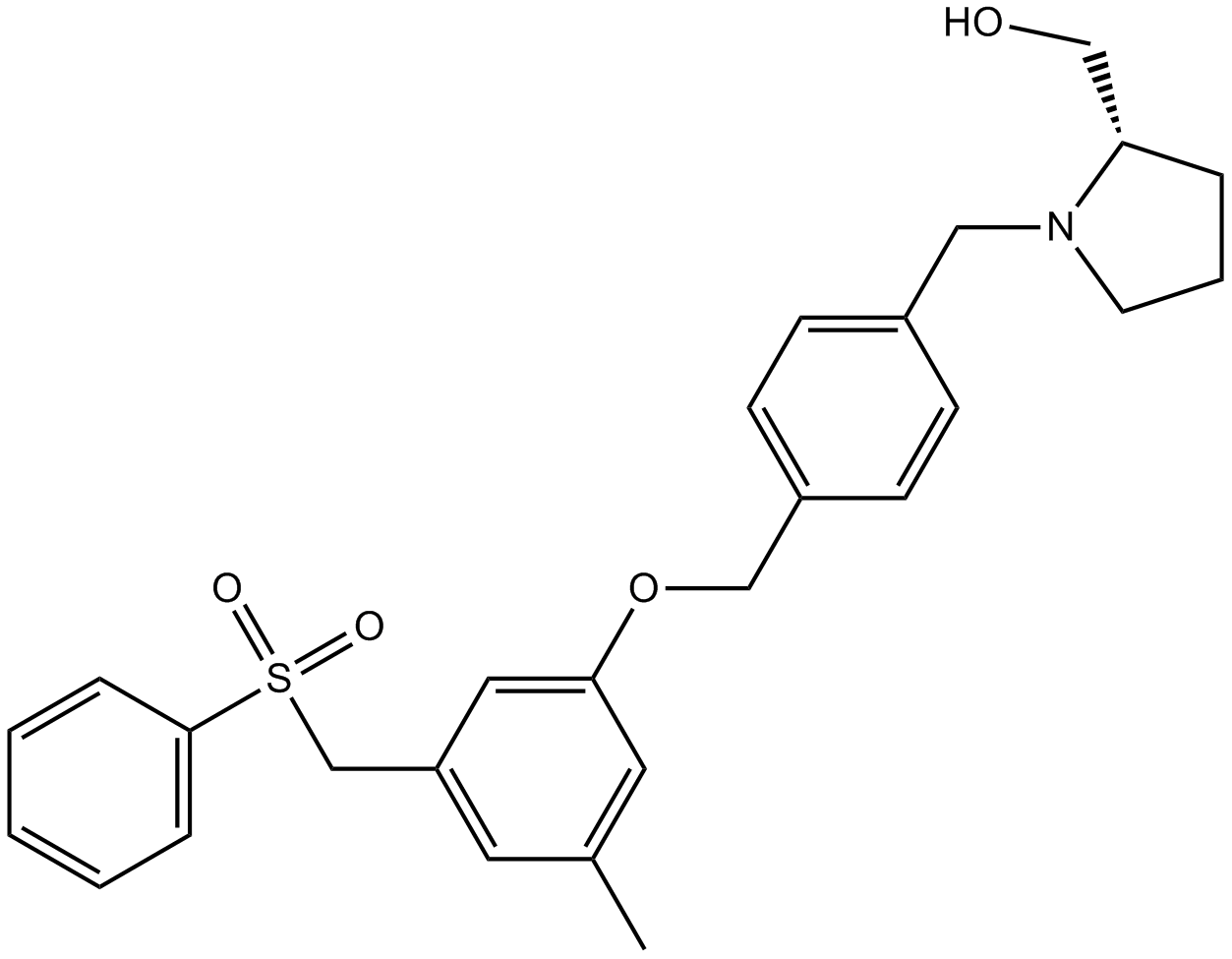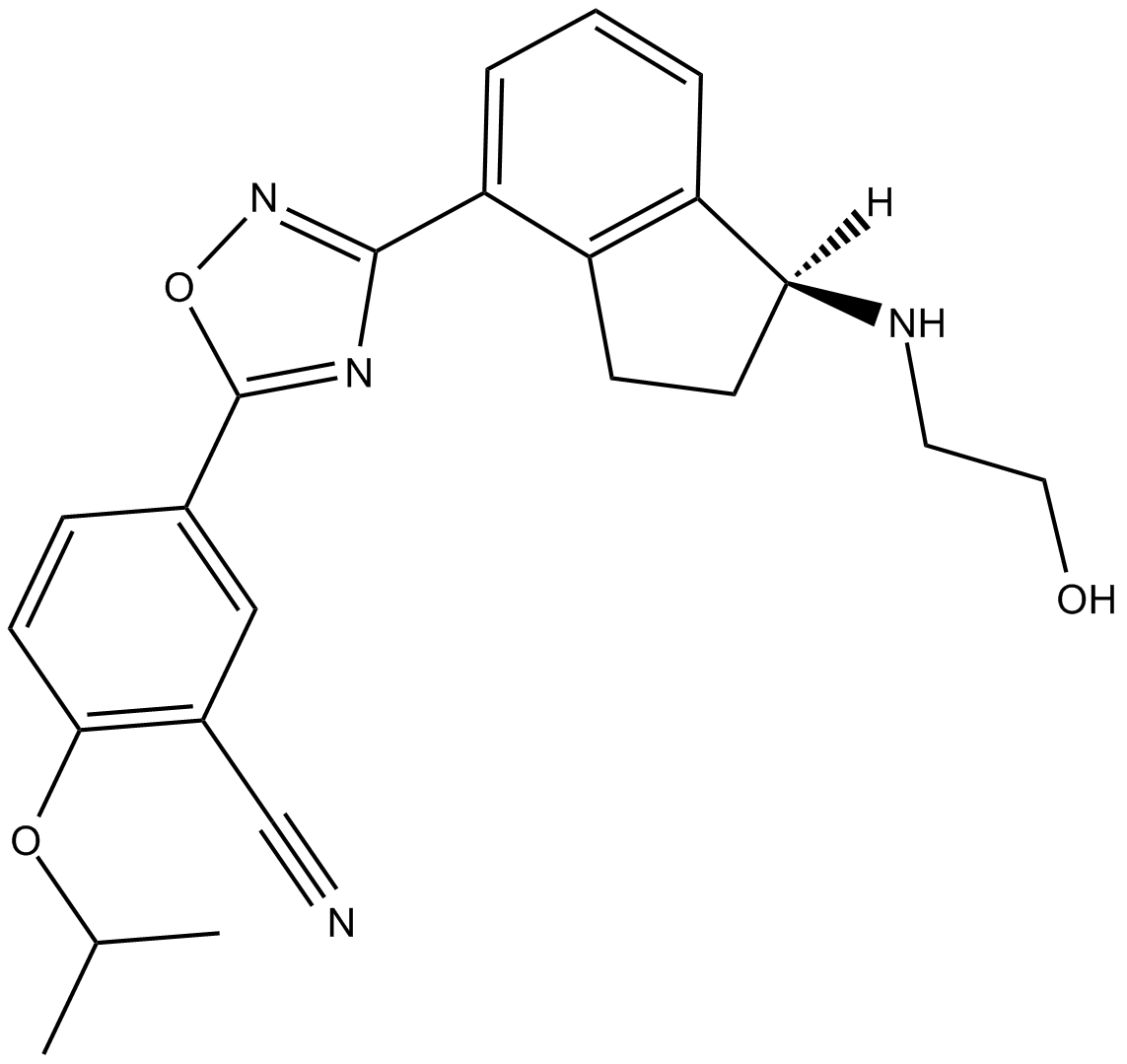Fingolimod (FTY720)
Fingolimod is a mechanistically novel, orally bioavailable therapy for multiple sclerosis (MS) [1].
Fingolimod is a FDA approved drug for Multiple sclerosis treatment. It is a folk medicine emerged from Fungi. Fingolimod was firstly found to be a therapeutic agent in organ transplantation. Then Fingolimod was found to have similar structure with natural sphingosine and interact with S1P1, S1P4, S1P5 and S1P3 receptors as high affinity agonist with EC50 values of 0.3-3.1 nM. It plays the role in MS treatment through receptor-mediated actions both on the immune system and in the CNS. Fingolimod can prevent normal lymphocyte egress and reduce the infiltration of autoaggressive lymphocytes into the CNS [1, 2].
References:
[1] Chun J, Brinkmann V. A mechanistically novel, first oral therapy for multiple sclerosis: the development of fingolimod (FTY720, Gilenya). Discovery medicine, 2011, 12 (64): 213.
[2] Chun J, Hartung H P. Mechanism of action of oral fingolimod (FTY720) in multiple sclerosis. Clinical neuropharmacology, 2010, 33 (2): 91.
- 1. Yuliya V. Medvedeva, Edward Sharman, et al. "Mechanisms of delayed ischemia/reperfusion evoked ROS generation in the hippocampal CA1 zone of adult mouse brain slices." Sci Rep. 2025 Jul 2;15(1):23439 PMID: 40604107
- 2. Oscar Badillo-Godinez, Jenni Niemi, et al. "Brain tumors induce immunoregulatory dendritic cells in draining lymph nodes that can be targeted by OX40 agonist treatment." J Immunother Cancer. 2025 May 19;13(5):e011548. PMID: 40389372
- 3. Yuliya V. Medvedeva, Edward Sharman, et al. "Mechanisms of delayed ischemia/reperfusion evoked ROS generation in the hippocampal CA1 zone of adult mouse brain slices." Res Sq . 2025 Apr 22:rs.3.rs-5640324 PMID: 40313775
- 4. Rui-Xue Wang, Luo-Yi Wang, et al. "FTY720 ameliorates experimental MPO-ANCA-associated vasculitis by regulating fatty acid oxidation via the neutrophil PPARα-CPT1a pathway." Rheumatology (Oxford). 2024 Jun 5:keae320. PMID: 38837706
- 5. Miao He, Qihua He, et al. "Intratumoral tertiary lymphoid structure (TLS) maturation is influenced by draining lymph nodes of lung cancer." J Immunother Cancer. 2023 Apr;11(4):e005539. PMID: 37072348
- 6. Jonah Clegg, Elisabetta Soldaini, et al. "Targeting lung-resident memory T cells via mucosal vaccination to combat staphylococcus aureus infections." Trends Immunol. 2021 Jan;42(1):6-17. PMID: 33309137
| Physical Appearance | A solid |
| Storage | Store at -20°C |
| M.Wt | 343.94 |
| Cas No. | 162359-56-0 |
| Formula | C19H34ClNO2 |
| Synonyms | Gilenia; FTY 720; FTY-720 |
| Solubility | ≥15.3 mg/mL in EtOH; ≥17.2 mg/mL in DMSO; ≥31.3 mg/mL in H2O with ultrasonic |
| Chemical Name | 2-amino-2-[2-(4-octylphenyl)ethyl]propane-1,3-diol;hydrochloride |
| SDF | Download SDF |
| Canonical SMILES | CCCCCCCCc1ccc(CCC(CO)(CO)N)cc1.Cl |
| Shipping Condition | Small Molecules with Blue Ice, Modified Nucleotides with Dry Ice. |
| General tips | We do not recommend long-term storage for the solution, please use it up soon. |
| Cell experiment: [1] | |
|
Cell lines |
MCF-7, MDA-MB-231, Sk-Br-3, HCT-116 and SW620 cells |
|
Preparation method |
The solubility of this compound in DMSO is >10 mM. General tips for obtaining a higher concentration: Please warm the tube at 37°C for 10 minutes and/or shake it in the ultrasonic bath for a while.Stock solution can be stored below -20°C for several months. |
|
Reaction Conditions |
IC50: 79.1 μM (MCF-7), 59.9 μM (MDA-MB-231), 72.9 μM (Sk-Br-3), >100 μM (HCT-116) and 40.0 μM (SW620); 48 hours |
|
Applications |
The IC50 values of fingolimod were determined by a WST-1 assay. The results demonstrated that treatment of the compound caused cell death in a dose-dependent manner. Fingolimod exhibited comparatively low IC50 values within the concentration range of 5-7 μM for all of the cells tested in this study. |
| Animal experiment: [2] | |
|
Animal models |
C57BL/6J mice |
|
Dosage form |
Intraperitoneal injection, 0.1 mg per kg of body weight |
|
Applications |
As early as 30 min after injection of fingolimod (0.1 mg per kg of body weight), the levels of phosphorylated ERK1/2 (pERK1/2) were significantly increased in hippocampal neurons. After an additional 30 min, BDNF mRNA levels were elevated, and protein levels were significantly increased in the hippocampus, the cortex, and the striatum after 48 h. |
|
Other notes |
Please test the solubility of all compounds indoor, and the actual solubility may slightly differ with the theoretical value. This is caused by an experimental system error and it is normal. |
|
References: [1] Nagaoka Y, Otsuki K, Fujita T, et al. Effects of phosphorylation of immunomodulatory agent FTY720 (fingolimod) on antiproliferative activity against breast and colon cancer cells. Biological and Pharmaceutical Bulletin, 2008, 31 (6): 1177-1181. [2] Deogracias R, Yazdani M, Dekkers M P J, et al. Fingolimod, a sphingosine-1 phosphate receptor modulator, increases BDNF levels and improves symptoms of a mouse model of Rett syndrome. Proceedings of the National Academy of Sciences, 2012, 109 (35): 14230-14235. |
|
| Description | Fingolimod is a mechanistically novel, orally bioavailable therapy for multiple sclerosis (MS). | |||||
| Targets | S1P1 | S1P3 | S1P4 | S1P5 | ||
| IC50 | ||||||
Quality Control & MSDS
- View current batch:
Chemical structure




